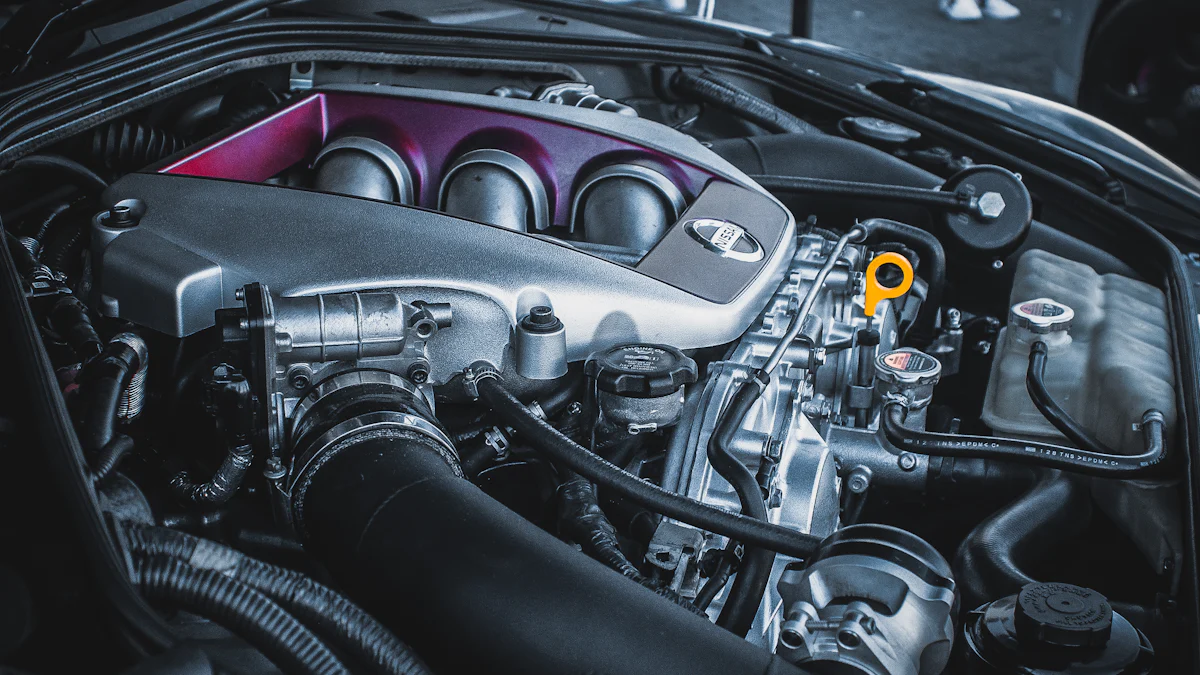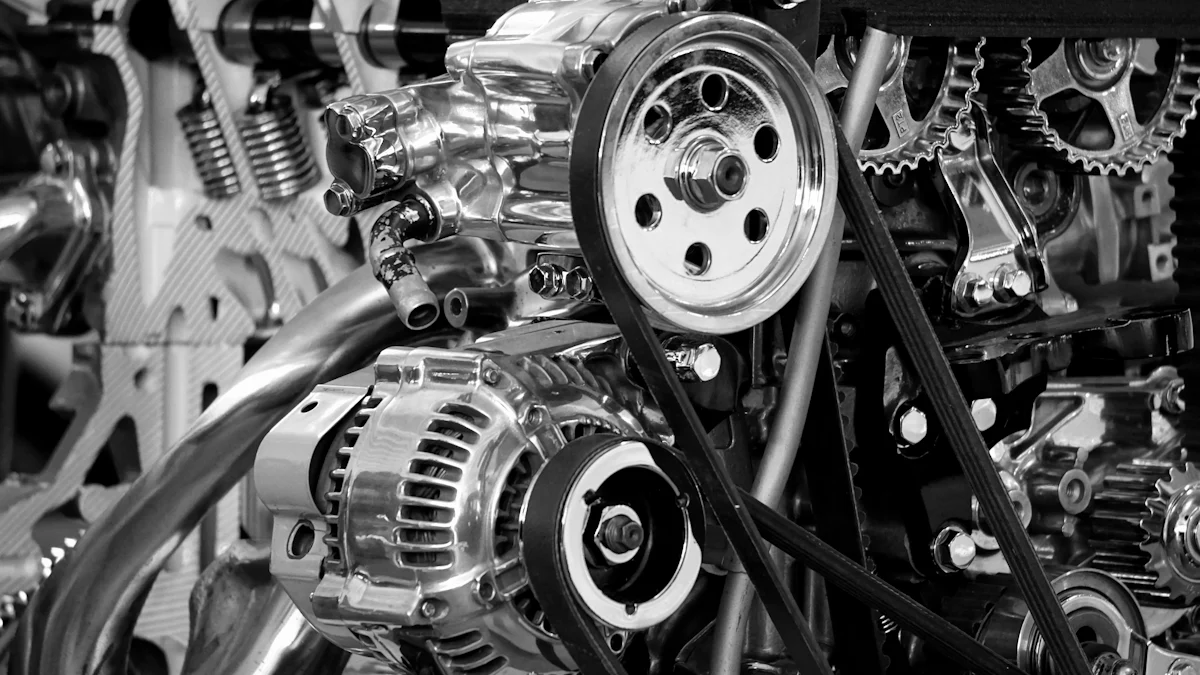
The harmonic balancer is a vital component in engine performance, crucial for reducing vibrations and ensuring smooth operation. Understanding the significance of this part is key to maintaining a healthy engine. This blog provides an insightful look into the harmonic balancer noise issues associated with harmonic balancers. By educating readers on how to identify and address these issues promptly, we aim to empower car owners to take proactive steps towards preserving their vehicle’s longevity.
Engine Vibrations
When considering engine vibrations, it is essential to recognize the underlying causes that may lead to this issue. One primary factor contributing to engine vibrations is a worn harmonic balancer. Over time, the harmonic balancer can deteriorate, resulting in imbalances within the engine system. Additionally, misalignment issues can also play a significant role in generating unwanted vibrations during engine operation.
The effects of these vibrations on engine performance should not be underestimated. They can accelerate the rate of wear and tear on various engine components, potentially leading to more severe problems down the line. Moreover, prolonged exposure to excessive vibrations can even cause potential engine damage, jeopardizing the overall functionality of the vehicle.
To address these concerns effectively, implementing suitable solutions and prevention measures becomes crucial. Engaging in regular maintenance routines can help detect early signs of harmonic balancer wear or misalignment issues before they escalate. Furthermore, seeking professional inspection services ensures that any underlying problems are identified accurately and resolved promptly.
Unusual Noises
Identifying Unusual Noises
Types of Noises
- Squealing: A high-pitched sound that typically indicates a loose or worn-out belt.
- Grinding: A harsh noise that may suggest issues with the harmonic balancer’s internal components.
- Rattling: An irregular noise that could signal loose parts within the engine system.
When Noises Occur
- During Engine Start-Up: Listen for any sudden or unusual sounds when starting the vehicle.
- While Accelerating: Pay attention to noises that coincide with pressing on the gas pedal.
- When Idling: Note any persistent or new noises while the engine is running but the vehicle is stationary.
Common Sources
Loose Components
- Loose components within the engine assembly can create rattling or knocking sounds, often mistaken for harmonic balancer issues.
Damaged Harmonic Balancer
- A damaged harmonic balancer can produce distinct noises, such as grinding or squealing, indicating potential internal faults.
Addressing the Issue
Immediate Actions
- Inspect Belt Tension: Check the tension of all belts connected to the harmonic balancer to ensure they are properly aligned and tightened.
- Listen Carefully: Identify and locate the source of the noise by listening attentively to pinpoint where it originates from in the engine compartment.
Long-term Solutions
- Professional Diagnosis: Seek a professional mechanic’s assistance to conduct a thorough inspection and diagnose any underlying issues accurately.
- Timely Repairs: Addressing unusual noises promptly can prevent further damage and prolong the lifespan of your vehicle’s components.
Illuminated Check Engine Light
The illuminated check engine light serves as a crucial indicator of potential issues within the vehicle’s system. Understanding the connection to the harmonic balancer can provide valuable insights into addressing underlying problems effectively.
Connection to Harmonic Balancer
Diagnostic Codes
When the check engine light illuminates, it often signifies that the vehicle’s onboard diagnostic system has detected an irregularity. Diagnostic codes, also known as trouble codes, offer specific information regarding the detected issue. These codes act as valuable clues for identifying the root cause of the problem.
Common Symptoms
In addition to diagnostic codes, certain common symptoms may accompany an illuminated check engine light. These symptoms can vary depending on the nature of the issue but may include abnormal engine noises, reduced performance, or unusual vibrations. Recognizing these signs promptly is essential for proactive maintenance.
Immediate Steps
Checking for Other Issues
Upon noticing an illuminated check engine light, it is advisable to conduct a comprehensive inspection of other vehicle components. Checking for other issues, such as loose connections or damaged parts, can help rule out additional sources of concern and focus on resolving the primary problem efficiently.
Consulting a Mechanic
Seeking professional assistance from a qualified mechanic is highly recommended when dealing with an illuminated check engine light related to the harmonic balancer. A skilled technician can perform in-depth diagnostics, interpret diagnostic codes accurately, and recommend appropriate solutions tailored to your vehicle’s needs.
Preventive Measures
Regular Check-ups
To prevent recurring issues with the harmonic balancer and avoid unexpected check engine light illuminations, regular check-ups are essential. Scheduled maintenance appointments enable early detection of potential problems, allowing for timely interventions and minimizing long-term damage risks.
Using Quality Parts
When addressing concerns related to the harmonic balancer and associated check engine light warnings, opting for quality parts is paramount. Utilizing genuine components or high-grade replacements ensures optimal performance and longevity for your vehicle’s critical systems.
By understanding the significance of an illuminated check engine light in relation to harmonic balancer issues and implementing proactive measures like thorough inspections and professional consultations, car owners can maintain their vehicles’ health effectively.
Noticeable Wobble
Detecting Wobble
Upon observing a noticeable wobble in your vehicle, it is essential to address this issue promptly to prevent further complications. Visual inspection plays a crucial role in identifying the source of the wobble. By visually examining the harmonic balancer and surrounding components, you can pinpoint any visible signs of damage or misalignment that may be contributing to the issue. Additionally, conducting a test drive allows you to experience firsthand how the wobble manifests during operation, providing valuable insights into its severity.
Causes of Wobble
The presence of a wobble can stem from various factors, with a damaged harmonic balancer being a common culprit. A compromised harmonic balancer can disrupt the engine’s smooth operation by failing to absorb torsional vibrations effectively. Moreover, misaligned components within the engine assembly can also lead to wobbling issues, affecting overall performance and stability.
Solutions
Addressing a noticeable wobble requires decisive action to restore your vehicle’s optimal functionality. Repair options are available for minor issues related to the harmonic balancer or other affected parts. Repair procedures involve rectifying any damage or misalignment present, ensuring that the engine operates smoothly without disruptions. In cases where repairs are not feasible or effective, opting for replacement procedures might be necessary to install a new harmonic balancer and eliminate the wobbling problem entirely.
Loud Knocking Noise
When faced with a loud knocking noise emanating from your vehicle’s engine, it is crucial to address this issue promptly to prevent potential damage and ensure optimal performance. Understanding the origins of this noise and its implications on engine components can guide you in taking the necessary steps to resolve the issue effectively.
Identifying Knocking Noise
When Noise Occurs
The knocking noise typically occurs during engine operation, especially when the vehicle is idling or accelerating. This distinct sound may resemble a repetitive tapping or knocking sensation, indicating irregularities within the engine assembly. Recognizing when this noise manifests can help pinpoint the underlying cause and facilitate timely intervention.
Severity of Noise
Assessing the severity of the knocking noise is essential in determining the extent of potential damage to engine components. A louder or more persistent knock may signify significant issues requiring immediate attention, while a milder noise could indicate early-stage concerns that need monitoring. Understanding the intensity of the noise aids in gauging the urgency of repairs or maintenance actions.
Potential Damage
Engine Components at Risk
The presence of a knocking noise poses risks to various engine components, including pistons, crankshafts, and bearings. Prolonged exposure to this disruptive sound can lead to accelerated wear and tear on these vital parts, compromising overall engine performance and longevity. Addressing the root cause of the knocking noise is paramount to safeguarding these critical elements.
Long-term Effects
Neglecting a knocking noise within your engine can result in detrimental long-term effects on its functionality. Continued operation without resolving this issue may escalate mechanical stress on internal components, potentially leading to severe damage or malfunctions. Taking proactive measures to rectify the knocking noise can mitigate adverse consequences and preserve your vehicle’s reliability.
Fixing the Issue
Immediate Repairs
Upon identifying a knocking noise, immediate repairs are recommended to prevent further complications and safeguard engine integrity. Initiating diagnostic procedures to isolate the source of the noise enables targeted repairs tailored to address specific component failures or misalignments efficiently. Timely interventions play a pivotal role in mitigating risks associated with unresolved knocking noises.
Preventive Maintenance
Implementing preventive maintenance strategies after addressing a knocking noise can enhance your vehicle’s resilience against future issues. Regular inspections, fluid checks, and adherence to recommended service intervals contribute to sustaining optimal engine health and performance. By prioritizing preventive measures, you proactively protect your vehicle from potential disruptions and costly repairs down the road.
By recognizing the significance of a loud knocking noise as an indicator of underlying engine problems, car owners can take proactive steps towards maintaining their vehicles’ reliability and longevity.
Proper maintenance and prompt replacement of harmonic balancer are essential to prevent engine damage and failure. If neglected, a failing harmonic balancer can lead to significant harm to the engine, risking its overall performance. The selection and installation of the harmonic balancer play a critical role in safeguarding the engine against vibrations and stress. Car owners should prioritize seeking professional assistance for diagnosis and repair when encountering any issues related to the harmonic balancer. By addressing these concerns promptly, vehicle owners can ensure the longevity and efficiency of their engines.
Post time: May-28-2024





